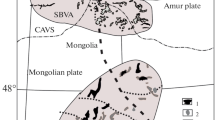Abstract
Commercial accumulation of mantle-derived helium in the sedimentary shell is discussed. Generally speaking, a commercial helium pool is formed by accumulated4He that comes from uranium and thorium via α-decay; therefore, it has a very low3He/4He value in the magnitude of 10-8. The helium concentration in some gas wells of eastern China oil/gas provinces is about or over 0.05% —0. 1%, consequently forming commercial helium wells (pools), such as the Wangjinta Gas Pool in Songliao Basin, Huangqiao Gas Pool in North Jiangsu Basin and some gas wells in Sanshui Basin. Studies have proved that when the3He/4He value of a helium gas pool is about 3.7 × 10-6 -7.2×10-6 namely mantle-derived helium in its total helium concentration accounts for 33.5%—65.4%, it is a crust-mantle dual-source or dominantly mantle-derived helium gas pool, which is a novel helium resource and its formation is mainly related to the distribution of megafractures.
Similar content being viewed by others
References
Craig, H., Lupton, J. E., Primordial neon, helium and hydrogen in oceanic hasalts,Earth Planet Sci Tett, 1976, 31: 369.
Craig, H., Lupton, J. E., Helium isotope variations,Trans Am Geophy Union, 1978, 58: 1194
Kaneoka, I., Takaoka, N., Noble gas state in the Earth’s interior—some constaints on the present state,Chemical Geology (Isotope Geoscience Section), 1985, 52: 75
Lupton, J E., Terrestrial inert gases—isotopic trace studies and clues primordial components,Annual Review Earth Plant Science, 1983, 11:371
Ozima, M., Podosek, F. A.,Noble Gas Geochemistry, Cambridge: Cambridge Univ Press, 1983
Xu Yongchang, Shen Ping, Tao Mingxinet al., A commercial accumulation of mantle-derived helium and the Tanlu megafracture zone,Chinese Science Bulletin, 1990, 35(12): 932
Qiu Songyu, Zhong Shiyou, Geological chararteristics of the Wanjinta CO2 gasfield in the southern Songliao Basin and its genesis,Oil & Gas Geology. 1985, 6(4) 434.
Tang Zhongyu, An approach to petrochemical characteristics of volcanism and volcanic rocks in the Sanshui basin,Marine Geology, 1987, (3): 50
Poreda, R. J., Jenden, P. D., Kaplan, E. R.et al, Mantle helium in Sacramento Basin natural gas wells,Geochim Cosmochim Acta, 1986, 65(5): 2847.
Sakata, S., Takahashi, M., Hoshino, K., Geochemical study on genesis of natural gases accumulated in deep valcaniclastic rocks,Journal of the Japanese Association for Petroleum Technology, 1986, 51(3): 32
Author information
Authors and Affiliations
Rights and permissions
About this article
Cite this article
Xu, Y., Shen, P., Tao, M. et al. Geochemistry on mantle-derived volatiles in natural gases from eastern China oil/gas provinces (I). Sci. China Ser. D-Earth Sci. 40, 120–129 (1997). https://doi.org/10.1007/BF02878370
Received:
Issue Date:
DOI: https://doi.org/10.1007/BF02878370




